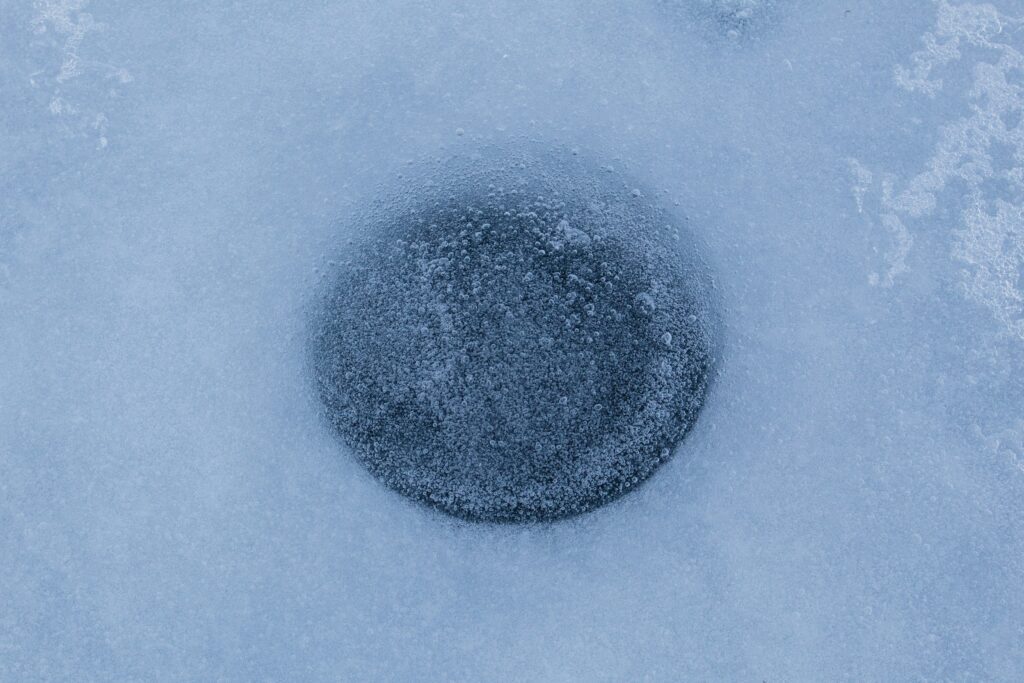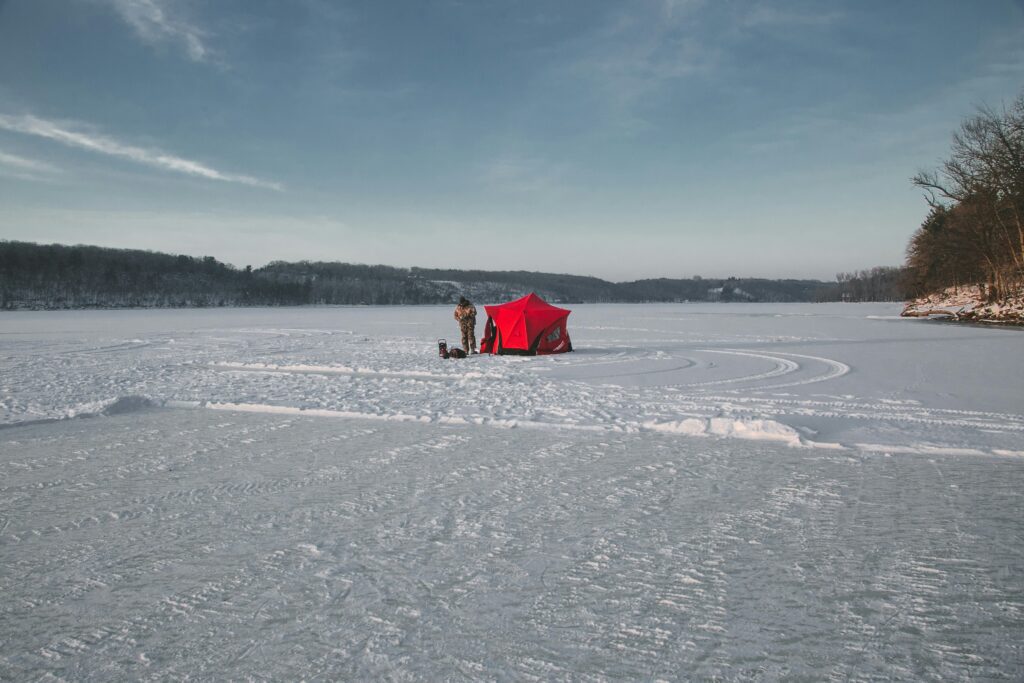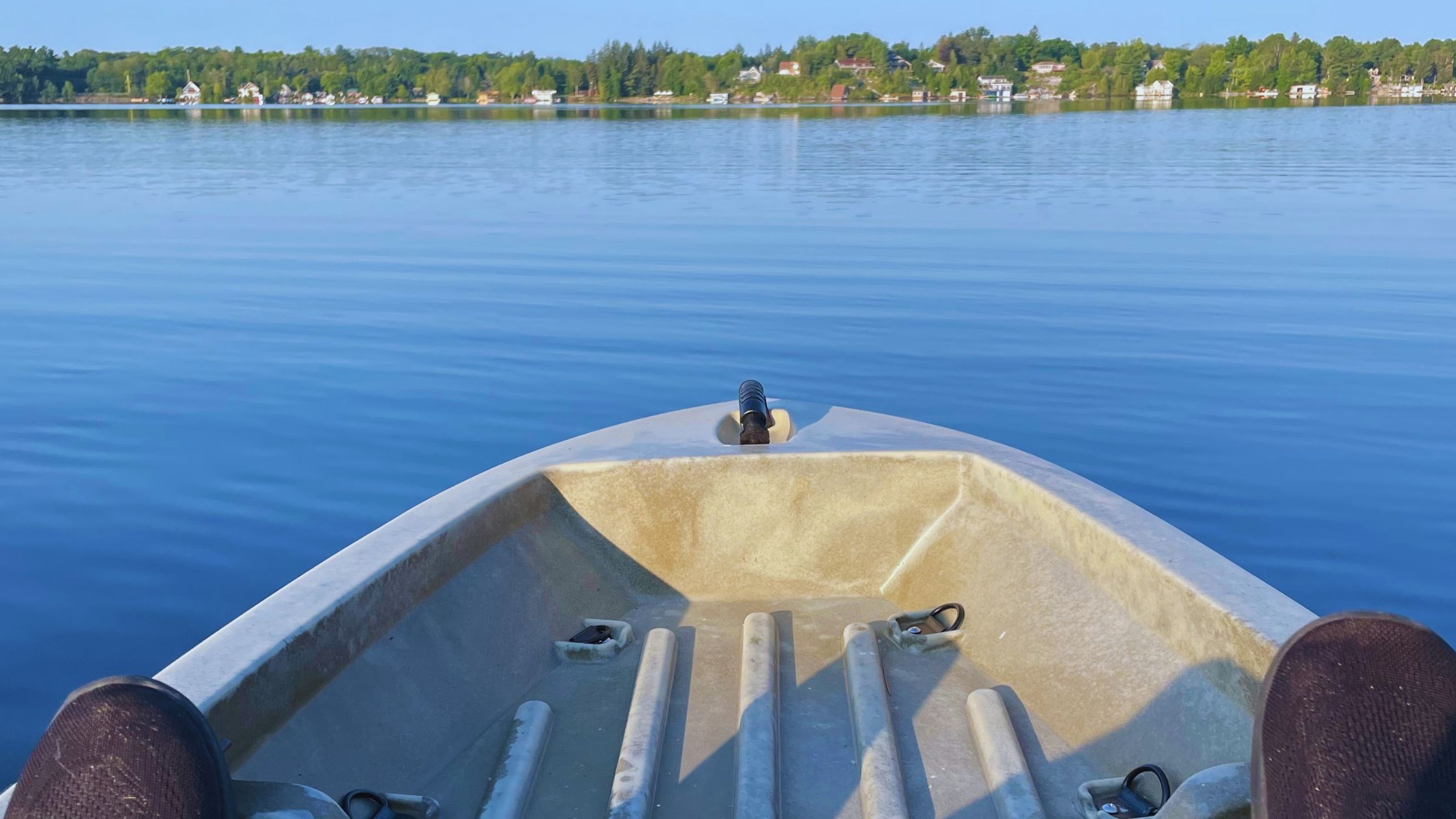Introduction: The Evolution of Ice Fishing Electronics
In the frosty world of ice fishing, electronics have sparked a renaissance, ushering in an era where anglers are equipped with sophisticated gadgets that can locate fish beneath thick ice.
How Electronics Can Revolutionize Your Ice Fishing Experience
Have you ever wondered what’s lurking below the ice? Ice fishing electronics have transformed the guessing game of what swims beneath your feet into a high-tech sport brimming with precision. Gone are the days when ice fishermen relied solely on intuition and prolonged periods of waiting.
Flashers, like the famous Vexilar FL-8, were among the first electronics to hit the ice, providing real-time information about fish and their depth. Imagine cutting your fishing hole and immediately seeing if you’re in the right spot—saves time, right?
Then came GPS-equipped devices, allowing you to mark and return to your honey hole without second-guessing your location. Devices like the Humminbird ICE series not only fish find but also offer GPS navigation, ensuring you’re not just drilling holes in random locations.
Sonar technology has evolved too, with devices offering ever-clearer views of what’s beneath. The dragonfly echoes of your bait and the looming presence of your next trophy catch now appear in high-definition on liquid crystal display screens.
By integrating Wi-Fi and smart technology, you can now view sonar returns on your smartphone or tablet with gadgets like the Deeper Smart Sonar, turning your mobile device into a powerful fish finder. It’s a game-changer allowing for mobility and comfort as you brace the cold.
And let’s not forget about augers — vital for breaking through the ice. Power augers, such as those created by Jiffy, have made it possible to drill multiple holes quickly, maximizing your fishing time and reducing fatigue. The Jiffy power auger, an invention dating back to 1948, has become an indispensable tool for modern ice anglers.
Digital maps and underwater cameras further enrich the experience, offering a glimpse into the watery world below. The clarity and detail ensure that your lure is not only in the right place but behaving in a way that entices fish to strike.
So, are you ready to boost your ice fishing game? Embrace the technological advancements and watch as your fishing tales become triumphs etched in digital memories. Don’t just drill a hole and hope — strategize with the latest ice fishing electronics and reel in results that’ll make your fishing buddies green with envy.
Types of Ice Fishing Electronics

Before you venture out onto the ice, let’s talk about the gadgets that can transform your experience. Ice fishing electronics are your underwater eyes and your guide through the wintery waters. They range from sophisticated sonar systems to nifty cameras, helping you pinpoint your catch and navigate the icy landscape. Ready to dive in?
Underwater Sonar and Fish Finders
Ever dreamed you could see beneath the ice? Underwater sonar and fish finders do just that by bouncing sound waves off objects below, which means you could spot fish, measure depth, and even discern bottom structures. They come in various types, from simple to complex, fitting every angler’s needs.
Sonar technology is like echolocation—send a sound wave down, and wait for it to echo back. Sophisticated algorithms then transform these echoes into understandable visuals. It’s like having your personal bat signal, but for fish!
Top Fish Finders for Ice Fishing
Chasing the best tools for the task? Brands like Garmin and Vexilar are leaders in the ice fishing game. They offer features that are game-changers such as high-resolution displays and portable bundles tailored for the icy waters.
Ice Fishing GPS Devices
Getting lost is last season! Ice fishing GPS devices are your compass in the cold, guiding you to your favorite spots and ensuring a safe return. With preloaded lake maps and the option to mark waypoints, these GPS units are a must-have.
Consider your GPS device your trusty sidekick, braving the vast white expanse with you. It ensures you’re on the right track to finding the hotspots without taking a long detour.
Models from the likes of Humminbird and Lowrance have been highly rated for their accuracy and additional features, like chart plotting, that make them indispensable for tech-savvy anglers.
Ice Fishing Cameras
What if you had the power to see through ice? Ice fishing cameras grant you that superpower! These cameras relay a real-time, underwater view directly to your screen, showing what’s happening beneath your hole.
As soon as your camera hits the water, it’s showtime! You can observe fish behavior, identify species, and even check if your bait’s doing its job. It’s like having a live underwater broadcast.
Looking for clarity and durability? Or perhaps a model that performs in low-light conditions? With brands like Aqua-Vu leading the pack, tailored options are available based on your specific ice fishing visions.
Ice Flashers
Ice flashers are compact sonar devices that offer real-time information about the water column. They display data in a circular format, making it easier to track fish movement and identify their depth. It is a classic tool that continues to be a vital part of any ice angler’s arsenal.
Remember, ice fishing technology can be your ally against the cold and mysterious underwater world. With the right gadgets, you can enjoy this winter hobby with confidence and success. So, what will be your newest ice-breaking companion?
Setting Up Your Ice Fishing Electronics
When venturing out onto the ice, having your electronics properly set up can be the difference between a good day and a wasted trip. Here’s how you can make sure your tech is your best fishing buddy.
Installation and Calibration
Getting started, installation and calibration are crucial. Ensure your sonar unit, such as a Garmin PanOptix, is mounted securely and that the transducer is positioned to give you a clear underwater view. Proper calibration means setting sensitivity levels; too high and you’ll get false readings, too low and you might miss the fish.
- Assemble your gear: Lay out your sonar system, transducer, and any mounting equipment.
- Mount the transducer: Attach it to a suitable location on the ice, ensuring it’s submerged properly.
- Power on: Turn on your device and adjust the settings as per the manufacturer’s guidelines.
- Check displays: Look for clear, readable feedback that shows fish and terrain accurately.
Optimizing Your Electronics for Ice Fishing
Different species and conditions require distinct settings. For instance, if you’re after panfish, you might set the zoom feature to focus on the bottom few feet of the water column. Remember, fish finders like the Humminbird ICE series have special ice modes optimized for these conditions.
Power Sources and Battery Management
Battery power is your lifeline out on the ice. Utilize lithium or sealed lead acid (SLA) batteries that are designed to last, reducing the need for frequent replacements. Consistently monitor your battery levels to avoid unexpected shutdowns.
Invest in a high-capacity battery that can handle the extreme cold. Brands like Marcum offer batteries that provide long-lasting power, ensuring you can spend more time fishing and less time charging.
Even the best batteries need some TLC in the cold. Insulate your power source to guard against the ice-cold temperatures and disconnect the battery when not in use to conserve power. This battery care approach will increase both the battery life and your effective fishing time.
Remember, the key to success with electronics on the ice is as much about proper setup and optimization as it is about maintaining your equipment. Get these elements right, and you’re in for a great day of ice fishing!
Using Electronics to Locate Fish

Electronics have revolutionized ice fishing, making it simpler and more efficient to find those elusive fish under the ice. With the right tools and understanding, you’ll be pinpointing your catch in no time. Let’s dive in, shall we?
Reading Sonar Displays
Sonar displays show the depth of water, contours of the lake bed, and, yes, even your potential catch! For instance, Vexilar units are famed for their super crisp displays, letting you see even the sneakiest fish.
Darker colors typically mean harder bottom compositions, such as rock or gravel, which can be fish hangouts. A nice solid arch? That could be a fish!
Your sonar might show a blob, but is it a school of crappies or just a weed bed? Learning to distinguish fish from other objects is vital, and higher-end models like the Garmin Echomap can make it a cinch with their high-definition displays.
GPS for Efficient Ice Hole Placement
Why play a guessing game with your drilling spots? GPS-equipped units, like the Garmin Echomap Ice Fishing Bundle, remember your honey holes and guide you back, saving time and effort.
When you find the hotspot, mark it on your fish finder’s GPS. Next time you venture out, you can head straight there. The Lowrance Hook series makes it easy to store and revisit the best spots with a few simple taps.
A quality GPS not only finds fish but also helps you steer clear of danger zones. Some models have maps showing lake depths and hazards to keep you safe while you focus on the fish.
Remember, when you’re using electronics for ice fishing, patience and practice make perfect. The more you get to know your tech, the better you’ll become at catching fish under the ice—without jumping in!
Ice Fishing Electronics Tips and Tactics
When you’re out on the ice, the right electronics can turn a good fishing trip into a great one. Let’s dive into harnessing the power of sonar, GPS, and cameras to elevate your ice fishing game.
Maximizing Your Sonar and Fish Finder
Your sonar is your underwater eyes. Make sure you’re using a model like the Humminbird ICE series to its full potential. Try tweaking the sensitivity settings to help distinguish between a fish and a mere change in bottom structure. Remember, proper interpretation of sonar returns can make or break your fishing experience.
Targeting Specific Fish Species
Certain species prefer specific habitats. Pike, for instance, often lurk near weedy areas while crappies suspend in deeper water. Use your fish finder to locate these habitats and increase your chances. Keep an eye out for the telltale arches on your device that signify fish—tight, consistent arches usually mean game on!
Advanced Sonar Techniques
Hone in on your sonar technique to differentiate between baitfish and your quarry. For example, a Vexilar FLX-28 can help you understand fish behavior—the way fish move toward your lure could indicate their size and species. Watch for those subtle movements on the display.
Using GPS for Ice Fishing Success
With advancements in GPS technology, you can return to your honey hole every season. Garmin’s GPSMAP series allows you to mark waypoints for promising fishing spots. Use these to plan your route and maximize time spent fishing rather than searching.
Creating a Personal Fishing Map
Did you know you can create custom maps? Devices like the Lowrance HOOK2 allow for personalized bathymetric mapping. You can chart depth changes and structure where fish might congregate—a secret map to treasure troves of fish!
GPS Drift Fishing Strategies
Ice fishing isn’t just stationary; try GPS drift fishing. Drift over a larger area and let your GPS device track your path. Later, analyze the route where you had the most bites and focus your efforts in those hotspots for a more productive day.
Ice Fishing Cameras for Better Angling
A camera like the Aqua-Vu can take your angling to the next level. Observe fish responses in real-time and adjust your tactics accordingly. Seeing is believing, and nothing beats the firsthand insight you gain from underwater visibility.
Consider live feeds a window into the underwater world. Utilize your camera’s live feed to make immediate decisions like lure changes or movement to new locations. Record these sessions; they’re not only fun to watch later but also educational.
Recording Your Ice Fishing Adventures
Recording your adventures is more than just for memories. Reviewing footage from a GoPro can reveal patterns in fish behavior and help you understand what works. Plus, sharing these moments could get you some valuable tips from the ice fishing community.
Maintenance and Care

Caring for your ice fishing electronics ensures they remain reliable companions during your icy adventures. Whether you’re wiping down a Vexilar flasher after reeling in a lunker or tucking your Humminbird into safe storage, a few easy routines can make all the difference.
Cleaning and Storing Electronics
After you’ve reeled in your final catch of the day, it’s crucial to clean your gear. Ice fishing electronics like Humminbird and Garmin units often just need a gentle wipe with a damp cloth to remove any water spots or ice residue. Avoid harsh chemicals that can damage screens or protective coatings. Remember, a clean device means a happy fisher!
Safe Storage During the Offseason
When the warm breeze melts the last of the frost, it’s time to stow your electronics. Store your devices in a cool, dry place. A bit of charge in your flasher’s battery can be a good idea so the cells keep their integrity.
Troubleshooting and Repairs
Encountering technical difficulties? First, check the manual! Many problems can be solved with a simple reset or calibration. If DIY isn’t cutting it, reach out to the manufacturer; they often have fantastic customer support.
Freezing temperatures can be harsh on electronics. Display issues or battery problems can often be resolved with a few DIY tricks. If you’re having trouble, consider swapping out old batteries before heading to a pro.
Professional Electronics Maintenance
If you’ve gone through the steps and your Humminbird is still acting up, or your Garmin is giving you the silent treatment, a professional tune-up may just bring it back to life. Remember, these devices are your underwater eyes; keep them sharp!
Frequently Asked Questions (FAQs)
How Do Fish Finders Work Under the Ice?
You might wonder how those fish finders manage to locate fish under a thick layer of ice. Well, they use sonar technology, sending out sound waves that bounce off objects and return to the device. The time it takes for the sound waves to return helps the fish finder determine the location and size of fish. The Humminbird ICE series, for example, is popular among anglers for its precision and ease of use under icy conditions.
What Are the Advantages of Using GPS for Ice Fishing?
Using GPS for ice fishing isn’t just about bragging rights; it’s practical! With GPS, you can mark productive spots and find your way back to them, even in a snowstorm. Let’s say you’ve found the perfect spot with your Garmin Echomap, having GPS means no more guessing games next time you’re out on the ice.
Can Ice Fishing Cameras Be Used in Dark or Murky Water Conditions?
Absolutely, ice fishing cameras aren’t just fair-weather friends! Many models come with infrared or low-light capabilities, allowing you to peer into the abyss of dark or murky waters. Think of it as giving you superhero-like vision where your quarry can’t hide, even when the water clarity is less than ideal.
How Should I Maintain and Protect My Ice Fishing Electronics in Extreme Cold?
You’ve invested a lot in your gear, so protect it like you would a pot of gold. Cold weather is tough on electronics, but here are a few tips:
- Keep them dry: Moisture is a no-go for electronic gear.
- Insulate: Consider using protective cases or even insulated bags.
- Battery care: Cold can zap your battery life, so keep spares handy and warm if possible.
Seriously, don’t let Jack Frost nip at your electronics!





